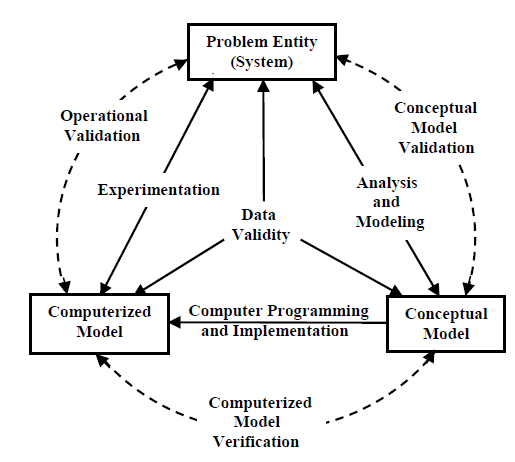Model validation and verification: Difference between revisions
No edit summary |
No edit summary |
||
| Line 28: | Line 28: | ||
''“Data validity ''is defined as ensuring that the data necessary for model building, model evaluation and testing, and conducting the model experiments to solve the problem are adequate and correct.” | ''“Data validity ''is defined as ensuring that the data necessary for model building, model evaluation and testing, and conducting the model experiments to solve the problem are adequate and correct.” | ||
[[File:ModellingProcessSargent.png|Simplified version of the modelling process. Source: Sargent, 2011.]] | |||
<div><br/> | <div><br/> | ||
---- | ---- | ||
Revision as of 08:54, 16 September 2016
Introduction[1]
The purpose of a model is to answer questions. In the case of the International Futures (IFs) model, the purpose is to answer “What if?” questions. For example, “What if the system begins in a certain state and behaves according to a series of assumptions?” and “What if this initial state and/or the assumptions were to change?” Exploring and understanding these questions will ideally lead to better informed decisions. The user of IFs, basing decisions off the outputs of the model, will naturally question whether the outputs are “correct.” Model verification and validation are the processes through which we can address these concerns.
Model verification and validation are crucial in the model development process. Below is a graphic illustrating the role of verification and validation in this process. The “problem entity” is the system being modeled. The “conceptual model” is the formal, logical representation of the system being modeled (problem entity). The “computerized model” is the conceptual model implemented on a computer. The conceptual model is developed through a “analysis and modeling” phase, the computerized model is developed through a “computer programming and implementation phase” and inferences about the problem entity can be drawn though the computerized model through an “experimentation” phase.
(Sargent, n.d.) defines the different types of validation and verification as follows:
“Conceptual model validation is defined as determining that the theories and assumptions
underlying the conceptual model are correct and that the model representation of the problem entity is “reasonable” for the intended purpose of the model.”
“Computerized model verification is defined as assuring that the computer programming and implementation of the conceptual model is correct.”
“Operational validation is defined as determining that the model’s output behavior has sufficient accuracy for the model’s intended purpose over the domain of the model’s intended applicability.”
“Data validity is defined as ensuring that the data necessary for model building, model evaluation and testing, and conducting the model experiments to solve the problem are adequate and correct.”
